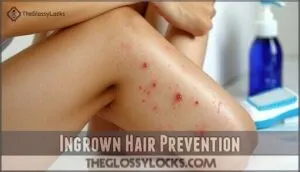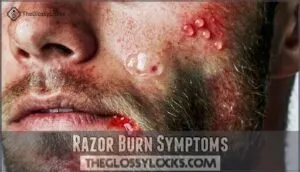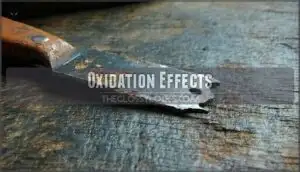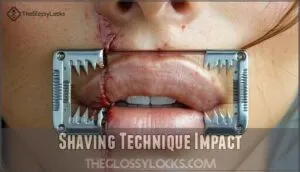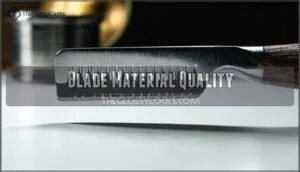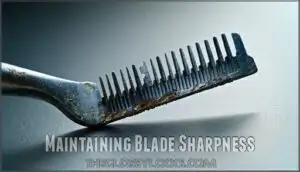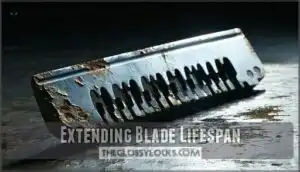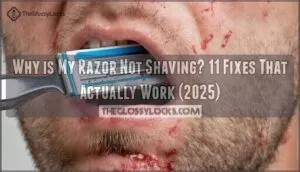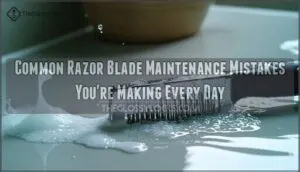This site is supported by our readers. We may earn a commission, at no cost to you, if you purchase through links.
 Shaving with dull blades is like trying to cut paper with a butter knife – it just doesn’t work well.
Shaving with dull blades is like trying to cut paper with a butter knife – it just doesn’t work well.
You’ll end up pressing harder, which creates more friction and irritation on your skin. Dull razors can’t cut hair cleanly, so they tug and pull instead, leading to razor burn, bumps, and increased risk of cuts.
They also leave behind stubble and missed spots, making your shave uneven. The extra pressure needed with a dull blade can cause micro-tears in your skin, potentially leading to infections.
Sharp blades glide smoothly with minimal pressure, giving you a cleaner, safer shave. There are several telltale signs your blade needs replacing, plus simple techniques to keep your razors performing at their best.
Table Of Contents
- Key Takeaways
- Dull Blade Risks
- Blade Dulling Factors
- Shaving With Dull Blades
- Maintaining Blade Sharpness
- Extending Blade Lifespan
- Frequently Asked Questions (FAQs)
- Is it better to shave with less blades?
- Do dull blades cause razor bumps?
- What happens if I shave with a dirty razor?
- Does shaving with a dull razor make you itchy?
- Can electric razors use dull blades safely?
- Do womens razors dull faster than mens?
- Can dull blades cause permanent skin scarring?
- Are disposable razors always considered dull blades?
- Will dull blades affect beard growth patterns?
- Conclusion
Key Takeaways
- You’ll press harder with dull blades, creating more friction that causes razor burn, bumps, and micro-tears in your skin that can lead to infections.
- Dull razors tug and pull hair instead of cutting cleanly, leaving you with stubble, missed spots, and an uneven shave that requires multiple passes over the same area.
- Replace your blades every 5-7 shaves for cartridges or 3-5 shaves for safety razors – don’t wait until they’re obviously dull, since the damage starts before you notice it.
- Proper blade care extends their lifespan – rinse thoroughly after use, dry completely, store in a dry place, and consider stropping techniques to maintain sharpness between shaves.
Dull Blade Risks
Using a dull razor blade turns every shave into a risky gamble with your skin’s health.
When your blade loses its sharp edge, it stops cutting cleanly through hair and instead tugs, pulls, and scrapes across your skin, creating a perfect storm for irritation, cuts, and infections.
A dull blade transforms your morning routine into a painful battle against your own skin.
This situation can lead to a variety of skin problems, but the primary concern is the increased risk of irritation.
Skin Irritation Causes
When you drag a dull razor across your face, you’re setting yourself up for a world of hurt.
That tugging and pulling action creates friction that irritates your skin and triggers razor burn.
Here’s what happens when your blade loses its edge:
- Increased friction – The dull razor drags instead of glides, causing shaving irritation
- Multiple passes – You’ll go over the same spots repeatedly, worsening skin sensitivity
- Pressure buildup – You’ll press harder to compensate, damaging your skin’s surface
- Product ingredients can’t protect against this mechanical trauma
- Hydration levels drop as your skin barrier gets compromised.
Sensitive skin suffers most from dull blades, regardless of shaving frequency or aftershave use.
Ingrown Hair Prevention
Dull blades increase ingrown hairs by 75% through uneven cutting that causes hair to curl back into skin.
Sharp blade sharpness prevents this by creating clean cuts.
Regular exfoliation methods remove dead skin cells blocking follicles.
Your skin type determines ideal hair removal frequency.
Proper shaving techniques with light pressure reduce irritation.
Smart clothing choices prevent post-shave friction that worsens ingrown hairs and shaving irritation.
These bumps can appear as small, red pimples.
Infection Risk Factors
Beyond ingrown hairs, bacterial growth becomes your skin’s worst enemy when using dull blades.
These compromised tools create the perfect storm for skin infections by breaking down your skin barrier and introducing harmful bacteria through microscopic cuts. Using high-quality shaving creams can help reduce skin irritation.
Here’s what puts you at risk:
- Open wounds from nicks become gateways for bacterial infections
- Cross-contamination spreads bacteria across your face with each stroke
- Poor razor hygiene allows germs to multiply on blade surfaces
- Weakened skin barrier can’t defend against invading microorganisms
- Accumulated debris on old blades feeds bacterial growth daily
Razor Burn Symptoms
Razor burn from a dull razor creates unmistakable warning signs your skin can’t ignore. You’ll notice persistent redness that lingers longer than normal, accompanied by uncomfortable itching that demands relief.
Severity factors include your skin type and shaving frequency. Treatment options range from cool compresses to aloe vera application.
Prevention methods focus on replacing your dull razor promptly and using proper shaving techniques to avoid painful razor bumps and ingrown hairs. Improper shaving can lead to ingrown hair issues, which can be a significant problem if not addressed properly with proper shaving techniques.
Blade Dulling Factors
Your razor blade doesn’t stay sharp forever, and several factors speed up the dulling process that you need to understand.
Oxidation from moisture exposure, poor cleaning habits, aggressive shaving techniques, and low-quality blade materials all contribute to faster blade deterioration.
Oxidation Effects
Even without use, blade oxidation weakens your razor’s edge through rust formation and material degradation.
Oxygen exposure causes blade corrosion that compromises the metal’s integrity, making cuts less precise.
This oxidation process creates microscopic rust particles that dull the cutting surface.
Disinfectant use helps prevent some corrosion, but blade rusting remains inevitable over time, leading to a loss of precision.
Improper Care Consequences
Poor care habits accelerate blade deterioration and create serious hygiene concerns.
Neglecting your razor turns it into a bacterial breeding ground that punishes your skin with every shave.
When you don’t rinse your razor thoroughly, hair and soap residue build up, promoting bacterial growth and blade rusting.
Sharing razors increases cross-contamination risks, while storing wet blades in humid bathrooms reduces their lifespan substantially.
These neglectful practices transform your razor into a breeding ground for germs.
Shaving Technique Impact
Your shaving techniques directly impact blade sharpness and performance. Poor methods accelerate dulling, leading to skin irritation, cuts, and nicks.
Master these fundamentals:
- Optimal Angle – Maintain 30-degree blade positioning
- Grain Direction – Follow hair growth patterns initially
- Pressure Control – Let blade weight do the work
- Pass Frequency – Limit repetitive strokes over same areas
Proper tool maintenance and correct shaving techniques preserve blade sharpness longer.
Blade Material Quality
The blade material you choose directly affects how quickly your razor becomes dull.
Steel composition matters—high carbon content adds strength and sharpness, while stainless steel offers superior corrosion resistance.
Hardness ratings determine edge retention, with harder materials maintaining their cutting ability longer.
Manufacturing processes control blade quality through precision grinding and coating applications.
Better blade durability means fewer replacements and improved blade condition over time, which is related to the overall edge retention.
Shaving With Dull Blades

When you shave with a dull blade, you’re basically dragging a blunt edge across your skin, creating excessive friction that leads to irritation, nicks, and razor burn.
This poor cutting performance forces you to apply more pressure and make multiple passes over the same area, increasing your risk of cuts and ingrown hairs.
Increased Friction Effects
When you press a dull blade against your skin, increased friction creates heat buildup and reduced glide.
This skin drag forces you to apply more blade pressure, causing shaving discomfort and irritation.
Dull blades literally scrape across your face instead of cutting cleanly, turning each stroke into sandpaper-like contact that leaves your skin red and angry.
Skin Damage Prevention
When using dull blades, you’re practically inviting skin damage to your face.
A solid pre-shave routine with gentle exfoliation removes dead skin cells that can clog your razor.
Proper hydration softens whiskers, reducing tugging that causes cuts and nicks.
Blade sterilization prevents bacteria from entering damaged skin.
Always finish with moisturizing aftershave to repair and protect against shaving rash and ensure proper hydration.
Shaving Angle Importance
Proper shaving angle impact makes the difference between smooth results and shaving irritation.
Maintain a 30-degree blade sharpness angle against your skin for ideal cutting performance.
Angle and technique work together—too steep causes nicks, too shallow means multiple passes.
Finding your angle takes practice, but blade angle consistency prevents dull blades from tugging.
Angle and irritation connect directly to your technique.
Pressure Application Risks
When you’re fighting a dull blade, you might think more pressure is the answer.
It’s not. Applying extra blade pressure with dull blades creates a perfect storm for nicks and cuts. Your skin sensitivity increases as the blade drags instead of gliding.
This poor shaving technique leads to razor burn and damaged skin. Proper pre-shave skin preparation can help to mitigate this issue.
Let gentle strokes do the work, not force.
Maintaining Blade Sharpness
You can keep your blades sharp longer with proper care and smart maintenance techniques. Learning these methods saves money and prevents the skin problems that come with using worn-out razors.
Sharpening Techniques
Your blade’s sharpness determines your shave’s success.
Sharpening stones offer precise control with different grits for various blade types. Pull-through sharpeners provide quick results through slots, while honing rods realign edges effectively.
Professional services deliver expert results when home methods aren’t enough. For high-quality tools, consider using specialized sharpening products.
Each blade sharpening technique requires consistent angles and proper maintenance for peak performance.
Stropping Methods
Beyond sharpening stones and pull-through sharpeners, stropping maintains your blade’s edge between sharpenings. This gentle technique realigns microscopic imperfections without removing metal like aggressive sharpening methods.
Master these stropping essentials:
- Leather Stropping – Use smooth leather with stropping compound for best results
- Denim Stropping – Heavy fabric works when leather isn’t available
- Palm Stropping – Gentle hand stropping for quick touch-ups
- Compound Use – Apply abrasive paste evenly before stropping
Pull the blade away from the leather strop’s surface, maintaining consistent stropping direction. Using the correct abrasive grit compounds can improve the polishing process. This prevents cutting the strop while polishing your blade’s edge effectively.
Cleaning and Storage Tips
After stropping your blade back to sharpness, maintaining that edge requires proper razor cleaning and blade storage habits.
Rinse your razor thoroughly with warm water after each use, removing hair and shaving cream buildup. Pat dry completely using a clean towel—moisture breeds bacteria and causes rust.
Store your razor in a dry location away from humidity. For extra protection, consider sterilizing with alcohol.
Clean the handle regularly with soap to prevent bacterial growth. Never share razors to avoid cross-contamination and maintain proper razor sanitation.
Replacement Schedules
Timing matters in blade replacement schedules.
You’ll want to swap cartridge razor blades every 5-7 shaves, while double-edge safety razor blades typically last 3-5 shaves.
Blade Lifespan Factors include your Shave Frequency, hair coarseness, and Razor Type.
At the point tugging or pulling occurs, it’s time for blade replacement immediately.
Ideal Performance requires monitoring your razor’s feel rather than strictly counting uses, as individual Blade Lifespan varies based on technique and care.
Extending Blade Lifespan
You can substantially extend your blade’s lifespan with proper maintenance and care techniques.
Smart preparation and storage habits will save you money while protecting your skin from the dangers of dull blades.
Safety Razor Maintenance
Safety razor maintenance extends your blade’s life substantially with proper care. Quality safety razors can last up to a year when maintained correctly.
Here’s how to keep your safety razor performing at its best:
- Soak in disinfecting solutions after each use to remove germs and debris
- Practice stropping techniques with leather straps to maintain sharpness between shaves
- Clean handles regularly and store blades in dry environments to prevent rust
Proper razor maintenance involves thorough cleaning, careful blade storage, and consistent sharpening routines that protect your investment. Regular cleaning helps with razor blade longevity.
Cartridge Razor Care
Cartridge razor blades need regular cleaning with rubbing alcohol to remove bacteria and debris.
After each shave, rinse thoroughly and dry completely to prevent rust and germ growth.
Clean handles regularly for proper hygiene.
Store cartridge blades in dry areas to maximize lifespan.
While stropping on denim can help sharpen edges, cartridge disposal should follow manufacturer guidelines since blade maintenance has limited effectiveness compared to safety razors.
Shaving Cream Selection
Why settle for harsh shaving products that work against your blade’s longevity?
Your shaving cream selection directly impacts how long your razor stays sharp. Choose mild, moisturizing shaving products with natural botanicals instead of harsh formulas containing fragrances, alcohols, and chemical detergents.
Quality shaving lather provides better glide, reducing friction that dulls blades faster. Using moisturizing shaving cream can improve the shaving experience.
Consider your skin types when selecting cream alternatives, and match application methods to your scent preferences for maximum shaving product impact.
Pre-Shave Preparation Importance
Proper preshave preparation protects your blade from unnecessary wear while safeguarding your skin.
Skin cleansing removes oils and debris that can dull razor edges. Preshave oil and warm water provide essential skin hydration, softening hair follicles for easier cutting.
This shaving preparation creates better shaving lather adhesion, reducing friction that damages blade edges. Smart product selection and technique refinement extend blade life substantially, through proper preshave preparation and essential skin hydration.
Frequently Asked Questions (FAQs)
Is it better to shave with less blades?
Fewer blades can actually be better for your skin.
Multiple blades often cause more irritation by making repeated cuts over the same area, increasing your risk of razor burn and ingrown hairs.
Do dull blades cause razor bumps?
Like trying to cut paper with scissors that barely close, dull blades create razor bumps by tugging and pulling hair instead of cleanly cutting it.
Causing irritation and inflammation that leads to painful bumps.
What happens if I shave with a dirty razor?
Shaving with a dirty razor increases your risk of bacterial infections, skin irritation, and razor burn.
Bacteria buildup on blades can enter cuts or nicks, potentially causing folliculitis or other infections that require medical treatment.
Does shaving with a dull razor make you itchy?
Studies show that 70% of skin irritation comes from dull blades.
Yes, dull razors definitely make you itchy because they tug and pull at hair instead of cutting cleanly, causing inflammation and razor burn.
Can electric razors use dull blades safely?
Electric razors can become dull and cause the same problems as manual razors—irritation, tugging, and discomfort.
You’ll need to replace or sharpen their cutting heads regularly for safe, effective shaving.
Do womens razors dull faster than mens?
Women’s razors don’t inherently dull faster than men’s razors. Blade durability depends on hair thickness, shaving frequency, and maintenance habits rather than the razor’s intended gender.
Can dull blades cause permanent skin scarring?
Ironically, the blade that promises a clean shave can leave lasting marks.
Yes, dull blades can cause permanent scarring through severe ingrown hairs, repeated cuts, and infections that damage your skin’s deeper layers permanently.
Are disposable razors always considered dull blades?
No, disposable razors aren’t always dull.
They start sharp but become dull with use, typically after five to seven shaves.
You’ll know they’re dull when they tug, pull, or cause irritation during shaving.
Will dull blades affect beard growth patterns?
No, dull blades won’t change your beard’s natural growth patterns. While they cause irritation, tugging, and ingrown hairs that temporarily affect appearance, your hair follicles determine growth direction permanently.
Conclusion
Think of your razor blade like a precision scalpel – surgeons replace theirs after each procedure because sharpness equals safety.
Shaving with dull blades forces you to apply extra pressure, creating unnecessary friction that damages your skin.
This leads to razor burn, ingrown hairs, and potential infections from micro-cuts.
Sharp blades require minimal pressure and glide smoothly across your skin.
Replace blades regularly, store them properly, and maintain good shaving technique to protect your skin and achieve consistently smooth results.


